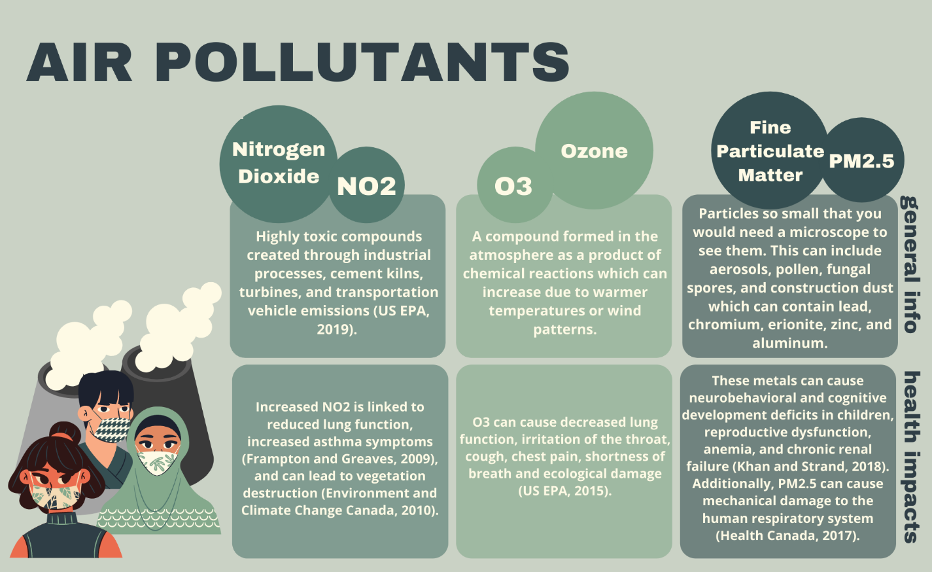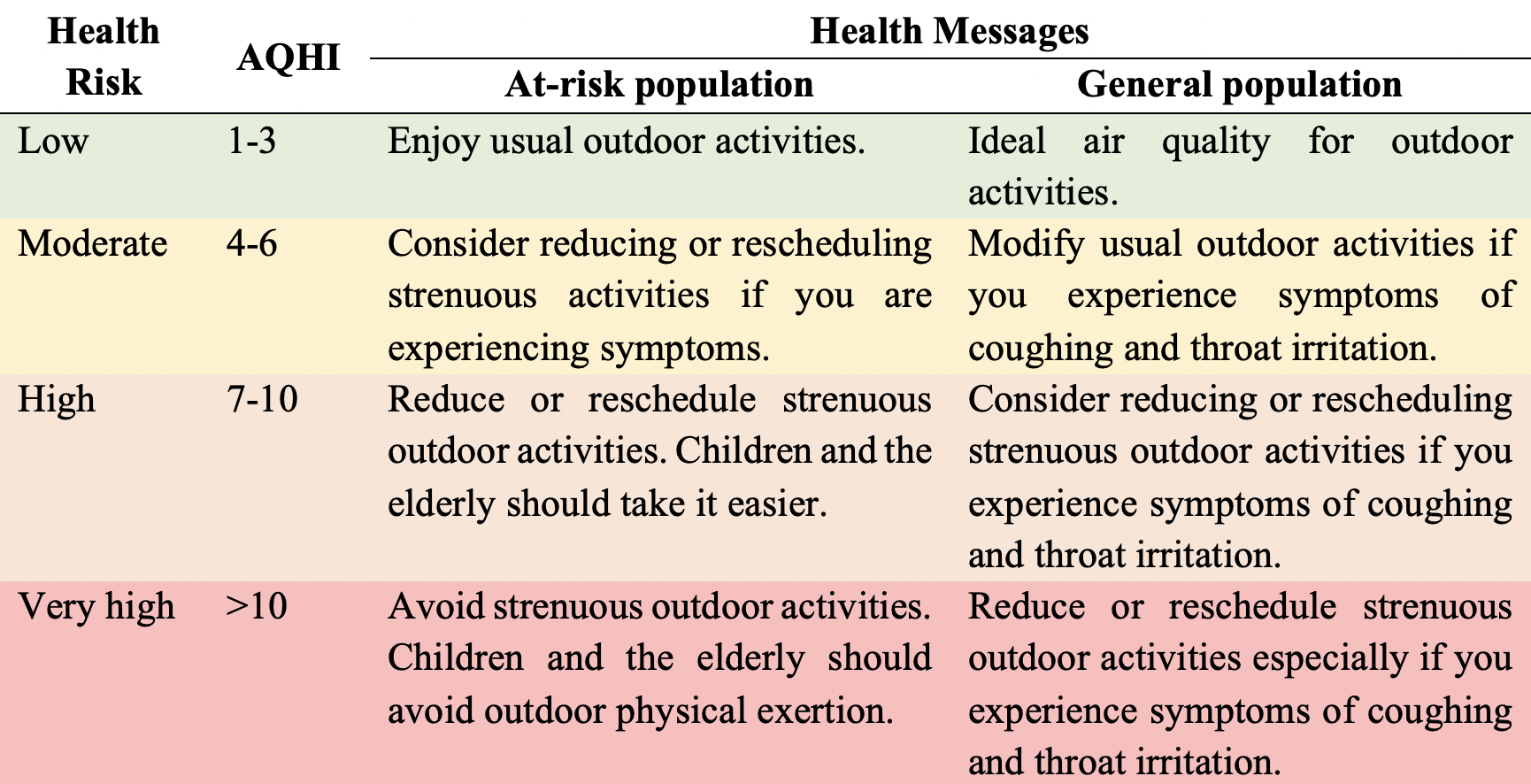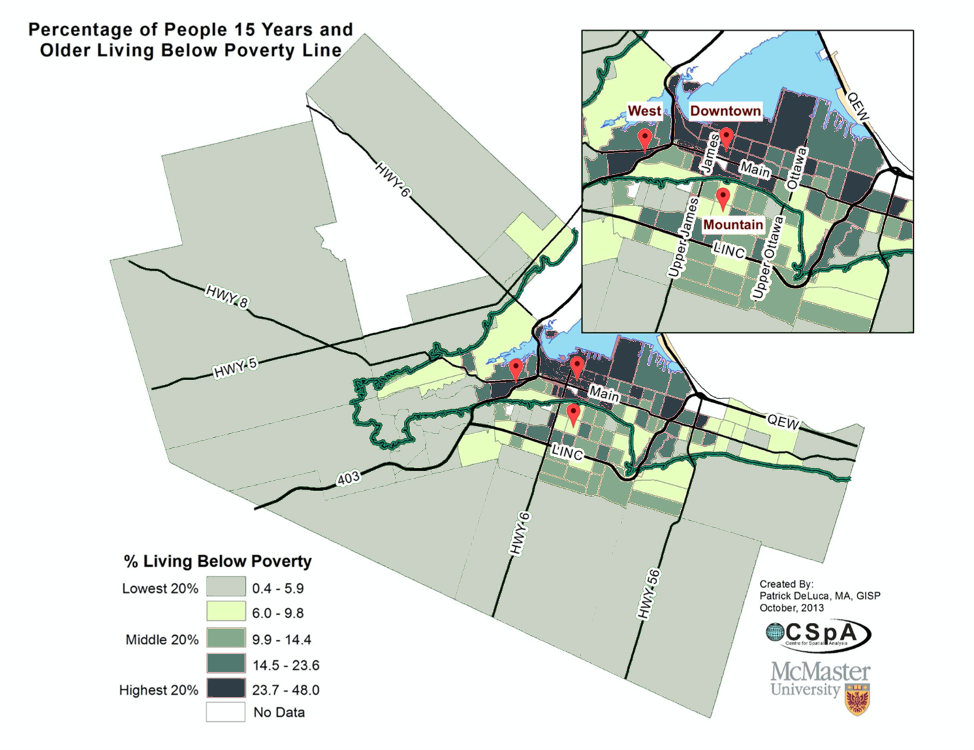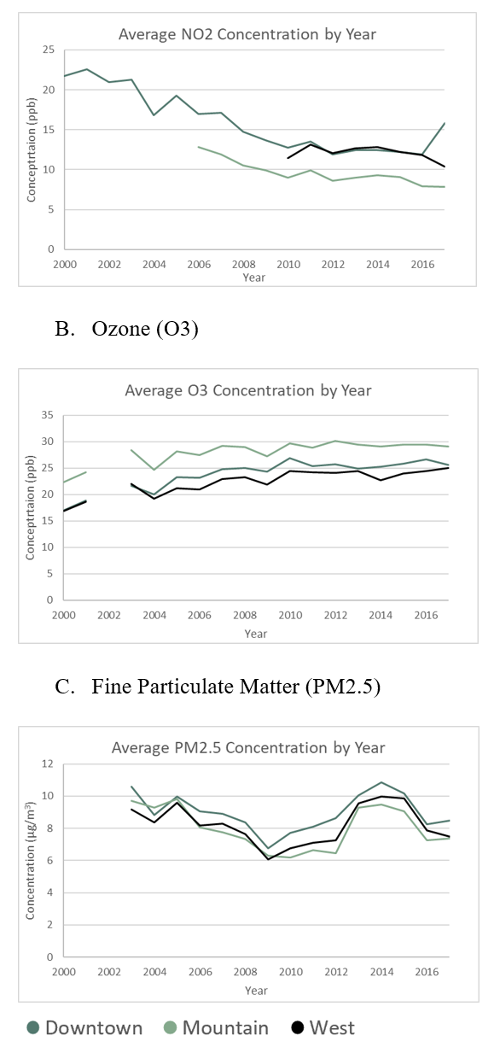Air Pollution in Hamilton
Ariana Mitchell, Grace Gabber, Kate Jamieson, and Sarah Watson
Introduction
Hamilton’s industrial history has resulted in air pollutants consistently being a concern, as they are linked to health-related impacts (Al-Dabbagh, 2011). We explore Hamilton’s contribution to this crisis by visualizing the trends in air pollutants over several years in three locations within the city. Current projects within the Hamilton community that aim to mitigate air pollution are also discussed.
Air Pollutants in Hamilton
There are three important pollutants that we will focus on: nitrogen oxides (NOx), ozone (O3), and fine particulate matter (PM2.5).

Figure 1: This figure describes the three main air pollutants in Hamilton and their associated health and environmental implications.
Health Implications of Air Pollution
Air pollution increases risk of respiratory infections, heart disease and lung cancer in addition to exacerbating preexisting conditions (World Health Organization, 2019), especially in young children and seniors (Filleul et al., 2003). Furthermore, people living in lower-income neighborhoods tend to have higher levels of pollution exposure on average than those in higher-income neighborhoods.
Air Quality Health Index and Socioeconomic Factors
The Air Quality Health Index (AQHI) is a scale indicating the cumulative health risk from air pollution. The AQHI communicates the overall risk caused by O3, NO2, PM2.5 daily and recommends behaviour modifications based on air quality (Table 1) (Radisic et al., 2016).
Table 1: Environment Canada Air Quality Index (AQHI) messages. At-risk population refers to individuals with heart or breathing problems. Adapted from Radisic et al., 2016.

In Hamilton, there is a trend of higher socioeconomic status (SES) in the suburban areas surrounding the city and lower SES in the lower city (Radisic et al., 2016). In lower SES neighborhoods that surround the city’s industrial corridor, there is a higher incidence of air pollution-related disease, like cancer (Buist, Johnston and DeLuca, 2013).

Figure 2: This figure depicts the locations of the three air quality data stations that are analyzed below: Hamilton West, Hamilton Downtown, and Hamilton Mountain. The locations of these stations are overlayed on a map of Hamilton that demonstrates socioeconomic status through the city and surrounding areas (adapted from DeLuca, 2013).

Figure 3: Concentrations (ppb) of Nitrogen Dioxide (NO2) [A], Ozone (O3) [B], and Fine Particulate Matter (PM2.5) [C]. Data is shown for three locations in Hamilton (see Figure 2) and averaged across several years as well as between months. As of 2013, the PM2.5 air monitoring method was changed to better detect fine particles, especially during the winter months, so the increase in 2013 and beyond does not necessarily reflect an actual trend but instead a more accurate reading. (data from (Air Quality Ontario, 2017).
Analysis of Air Pollutants in Hamilton
To visualize the presence and risk of these air pollutants, data from Air Quality Ontario was gathered and synthesized. As seen in Figure 3, nitrogen dioxide concentrations have decreased recently, especially seen in the downward trend downtown. O3 concentrations have shown a small but consistent increase since 2000. Fine particulate concentrations do not show a clear trend, however this was caused by changes in air monitoring methods. There is a significant difference in pollutant concentration between locations for ozone and nitrogen dioxide. This sheds light on disparities that may exist within the city.
Climate Change Projects in Hamilton
Many organizations in Hamilton aim to reduce the impact of climate change. The Hamilton City Council declared a climate change emergency in 2018 and a target to reduce carbon emissions by 2050 (Hamilton, 2020). Next steps for City Council involve identifying actions to increase energy efficiency and decrease emissions, allowing for creation of a more detailed plan, from which future models can be made to predict the trajectory of these efforts (Hamilton, 2020). “Let’s Talk about the Weather” is a community action plan providing a list of attainable goals to combat climate change (Hamilton, 2020). Clean Air Hamilton is another local organization created with the goal of improving Hamilton’s air (Clean Air Hamilton, 2021). Not only do these organizations hope to reduce GHG emissions in Hamilton, but also aim to increase the community’s awareness as to how citizens can contribute to reducing emissions.
Conclusion
Air pollutants are a byproduct of factors that contribute to climate change. They are important to the discussion of climate change for several reasons including health impacts to humans. Identifying areas of concern is the first step to combating Hamilton’s air pollution.
References
Air Quality Ontario, 2017. Air Pollutant Data. [online] Available at: http://<span</span>www.airqualityontario.com/history/index.php> [Accessed 7 Mar. 2021].
Al-Dabbagh, O., 2011. Hamilton’s Air Quality: Status and Expected. pdf. McMaster University.
Buist, S., Johnston, N. and DeLuca, P., 2013. Code Red. [online] Code Red The Spec. Available at: https://<span</span>codered.thespec.io/> [Accessed 6 Mar. 2021].
Clean Air Hamilton, 2021. Clean Air Hamilton – Dedicated to improving air quality in Hamilton’s community. Available at: https://<span</span>cleanairhamilton.ca/> [Accessed 7 Mar. 2021].
DeLuca, P., 2013. Percentage of People 15 Years and Older Living Below Poverty Line. Code Red Project. Available at: https://<span</span>storymaps.arcgis.com/stories/29dcebcbb83448989f8ca0a8d2d49158>.
Environment and Climate Change Canada, 2010. Common air pollutants: nitrogen oxides. [program descriptions] Government of Canada. Available at: https://<span</span>www.canada.ca/en/environment-climate-change/services/air-pollution/pollutants/common-contaminants/nitrogen-oxides.html> [Accessed 7 Mar. 2021].
Filleul, L., Baldi, I., Dartigues, J. and Tessier, J., 2003. Risk factors among elderly for short term deaths related to high levels of air pollution. Occupational and Environmental Medicine, 60(9), pp.684–688.
Hamilton, C. of, 2020. Community Energy and Emissions Plan. [Text] Available at: https://<span</span>www.hamilton.ca/city-initiatives/priority-projects/community-energy-and-emissions-plan> [Accessed 7 Mar. 2021].
US EPA, 2019. Nitrogen Oxides Control Regulations. [Overviews & Factsheets,] Available at: https://<span</span>www3.epa.gov/region1/airquality/nox.html> [Accessed 7 Mar. 2021].
US EPA, O., 2015. Ground-level Ozone Basics. [Overviews and Factsheets] US EPA. Available at: https://<span</span>www.epa.gov/ground-level-ozone-pollution/ground-level-ozone-basics> [Accessed 7 Mar. 2021].
World Heatlh Organization, 2019. Health consequences of air pollution on populations. [online] Available at: https://<span</span>www.who.int/news/item/15-11-2019-what-are-health-consequences-of-air-pollution-on-populations> [Accessed 1 Mar. 2021].